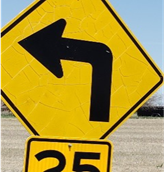By K C Pawling, Road Safety and Loss Prevention Specialist
County road departments must install and maintain signs according to the latest edition of the Manual on Uniform Traffic Control Devices (MUTCD). I understand with the 864 pages in the MUTCD someone could get lost in all the guidance that the manual provides. As I travel the state, I’ve noticed some, to put it nicely—creative—sign mountings used by both state and county governments here in Nebraska.
One of the practices I commonly see on the county road system is the mounting of two signs on one signpost. Typically, traffic signs should be installed on separate posts, but it is allowed to post more than one sign on a single post in some instances. One of those instances is when the signs supplement each other. For example, an advisory speed plaque on a horizontal alignment sign. Typical horizontal alignment signs are turn and curve signs.
I’m encouraged to see that most seem to understand which advisory speed plaque should be used with a curve or turn sign. This is great news, as generally it has little to do with the geometric shape of the road, and everything to do with the safe speed at which we can navigate the road. This safe speed is found by completing a curve speed study.
Now when it comes to the installation of the necessary warning signs, either curve or turn with an advisory speed plaque, that’s where I am seeing problems. The typical size of a county road sign is 30”x30” and advisory speed plaques are 18”x18.” The minimum height of the warning sign is 5 feet from the edge of the traveled way according to the MUTCD. NIRMA recommends taking this measurement from the crown of the road. When an advisory speed plaque is added, it needs to be installed at the height of 4 feet from the crown of the road. The reason for this recommendation is to allow for potential shifting of the road edge through routine maintenance and natural conditions.
When the advisory speed plaque is added, it is important to note that the signs should NOT be overlapping over one other. When the advisory speed plaque is mounted to the signpost at the correct height, 4 feet, that is going to move the bottom of the curve or turn sign up to 5 ½ feet to accommodate the 18” sign below it. Keep in mind, these are MINIMUM heights. We can move the signs up, but not down below the minimum.
The MUTCD speaks directly to sign shape and specific height installations for each sign. It also has very detailed specifications for the size of signs and applications related to speed and traffic volume of roads. These are all mandatory legal requirements for sign installations. When a warning sign and advisory speed plaque overlap, it arguably alters the size and shape of the signs. This might give a Plaintiff’s attorney a chance to assert that the signs no longer comply with the size and shape requirements in the MUTCD. When the advisory speed plaque overlaps the warning sign, it also reduces the exposed surface area of the warning sign and may make one or the other less likely to be noticed or heeded by drivers. Please refer to the picture below for a visual example of one such overlap:

If you find that your county has signs mounted in an overlapping manner, or that any of your signs do not meet the minimum heights, please get them corrected as soon as possible. The intention of the sign auditing process is to limit your exposure to any claims that might arise out of incorrect or inadequate signing. As always, if you have any questions regarding road signing practices, I can be reached at kcpawling@nirma.info or 402-310-4417.

